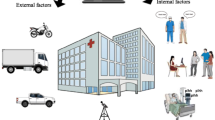Abstract
Electromagnetic interference (EMI) with electronic medical equipment by radio waves from mobile telephone handsets has been reported and is currently receiving wide attention. The possibility of EMI with electronic medical equipment by radio waves coming into the hospital has also been pointed out. But so far, there are no reports measuring the frequency distribution of electric field intensity induced by incoming radio waves. Therefore, we measured electric field intensity induced by radio waves coming into our 11-floor hospital, which was under construction. The maximum intensity observed was about 200 V/m at 2.79 GHz, from airport surveillance radar waves. The maximum intensity induced by radio waves from cellular phone base stations was 1.78 V/m. These data show that various frequencies of radio waves are common in this urban area, and that they induce strong electric field intensity. This strong electric field intensity might cause EMI with electronic medical equipment. Measurement of the electromagnetic environment should be done by each hospital in urban areas to prevent EMI with electronic medical equipment.
Similar content being viewed by others
REFERENCES
Anonymous, Radiofrequency Interference with Medical Devices. IEEE Eng. in Med. Biol. Magazine 17(3):111–114, 1998.
Hayes, D., Wang, P., Reynolds, M., et al., Interference with Cardiac Pacemakers by Cellular Telephones. New Eng. J. Med. 336(21):1473–1479, 1997.
Dwyer, D., Medical Device Adverse Events and Electromagnetic Interference. Intl. J.Trauma Nursing 5(1):19–21, 1999.
Electromagnetic Compatibility Conference (Japan), Research Report of the Usage of Radiocommunication Equipment such as Cellular Telephone Handsets, Association of Radio Industries and Business (Japan), 1997.
Hoolihan, D., Medical Device Electromagnetic Interference-ANSI Issues Professional Program Proceeding, Electronics Industries forum of New England, 1997, pp. 123–130.
VIFKA(Netherlands), Recommendations Regarding the Use ofPocketTelephones within Health Care Institutions, Sept. 1995.
Health Protection Branch (Canada), Digital Cellular Phone Interference with Cardiac Pacemakers Medical Devices, Publications, Alerts I.L. No. 108, Nov. 1995.
FDAMDS-201–0004, Electromagnetic Compatibility Standard For Medical Devices,U.S. Department of Health, Education andWelfare, Public Health Service, Food and Drug Administration, Beurau of Medical Devices, Oct. 1979.
International Electrotechnical Commission, International Standard IEC 60601–1–2 Medical Electrical Equipment Part 1: General Requirements for Safety 2.Collateral Standard: Electromagnetic Compatibility Requirements and Tests, International Electrotechnical Commission, Geneva, Switzerland, 1993.
Silberberg, J., Performance Degradation of Electronic Medical Devices Due to Electromagnetic Interference. Compliance Engineering, Fall 1993.
Williams, R., Keeping Medical Devices Safe from Electromagnetic Interference. FDA Consumer 1: May 1995.
Silberberg, J., What can/should We Learn from Reports of Medical Device Electromagnetic Interference? Electromagnatics, Health Care and Health, EMBC 95 19–20, Sept. 1995.
The Wireless Technology Research, L.L.C. (U.S.A.), A Clinical Study To Assess the Potential for Hand-Held Wireless Telephones To Interfere with Implanted Pacemakers, Aug. 1995.
Electromagnetic Compatibility Conference, Research Report of the Usage of Radio-Communication Equipment such as Cellular Telephones (in Japanese), Association of Radio Industries and Business (Japan), Apr. 1996.
Ministry of Health andWelfare, Pharmaceutical and Medical Safety Bureau, Information on Adverse Reactions to Drugs No. 137(4), May 1996.
Foster, K., Soltys, M., Arnofsky, S., et al., Radiofrequency Field Surveys in Hospitals. Biomed. Instr. Tech. 30(2):155–159, Mar-Apr. 1996.
Hanada, E., Watanabe, Y., Antoku, Y., et al., Hospital construction materials: Poor shielding capacity with respect to signals transmitted by mobile telephones. Biomed. Instr. Tech. 35(4):489–496, 1998.
Telecommunication Bureau, Ministry of Posts and Tele-communications (Japan), Frequency Allocation Table of Japan, Jun. 1997.
Ministry of Posts and Telecommunications (Japan), Frequency Allocation Search System, In their web page (http://www.tele.mpt.go.jp:8080/fow.html), 2000.
Ministry of Posts and Telecommunications (Japan), PROMPT REPORT on the Number of Subscribers of Cellular Telephone and PHS (Personal Handy-Phone System) in Japan. In their web page (http://www.mpt.go.jp/eng/Statistics/MobilePhone/Handy-phone-imm-e.html), Sept. 2000.
Author information
Authors and Affiliations
Corresponding author
Rights and permissions
About this article
Cite this article
Hanada, E., Kodama, K., Takano, K. et al. Possible Electromagnetic Interference with Electronic Medical Equipment by Radio Waves Coming from Outside the Hospital. Journal of Medical Systems 25, 257–267 (2001). https://doi.org/10.1023/A:1010727220929
Issue Date:
DOI: https://doi.org/10.1023/A:1010727220929




